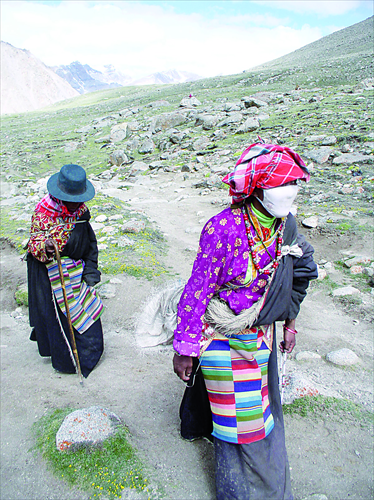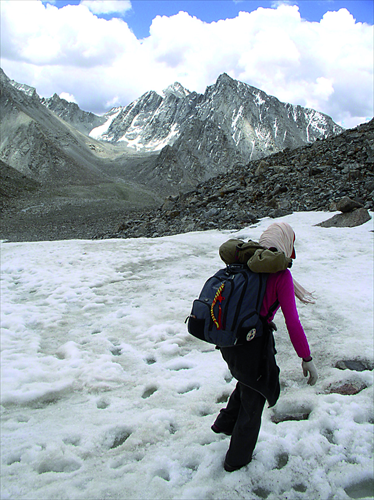Karma kora
Dare to walk the dangerous, 52-kilometer pilgrimage around Mountain Kailash, Asia’s most sacred summit
The Tibetan word "kora" describes the ritual path followed by devout followers of Buddhism and Hinduism in their effort to attain spiritual absolution for the sin of being alive.
Throughout Tibet one can see the faithful making clockwise kora around temples and other hallowed grounds, though none are as consecrated as the 52-kilometer circumambulation of Mountain Kailash in western Tibet, Asia's most sacred mountain.

Tibetan prayer flags at the base of Mountain Kailash Photos: Tom Carter/GT
I begin my pilgrimage of Kailash at dawn, guided only by a colorful trail of prayer flags. An unmarked path behind the Gyangdrak and Selung monasteries leads to a sky burial site, where Buddhists bid farewell to their dead by dismembering corpses and leaving the remains for birds of prey, which form kora of their own above.
By midday I arrive at Chuku Monastery, which hugs the western hillside above the Lha-Chu River.
Aside from being the most holy Buddhist site in Asia, Kailash is also the source of four great rivers - the Sutlej, which flows to India; the Indus to Pakistan; the Karnali, which feeds the Ganges; and Tibet's own Yarlung Tsangpo.
In western Tibet, dusk does not arrive until 10 pm, bathing the mountain in ruby-red hues. Spent, I turn in for the night at a lone yurt tent on the grassy banks of Damding Donkhang. Setting my head down on the filthy pillows, I immediately crash.

Buddhist pilgrims, many of them elderly Tibetan women, can be seen completing multiple kora around Mountain Kailash.
My own private goddess
I am cautioned the following morning by a solemn group of Indian Hindus who had one of their party die overnight that the second half of the Kailash kora is the most difficult.
The man's heart gave out while traversing the 5,600-meter Drolma-La pass on the north side of Kailash. For a Hindu to pass away atop their mythical Mountain Meru is auspicious, though I feel bad for the friends and family who have to carry the cadaver around the rest of the mountain.
Crossing the Lha-Chu river into the Drolma-Chu Valley, I fear I might become Kailash's next casualty.
Here, the steep path starts to thin out - as does the air - and then disappears altogether into ice and fresh snowfall. Before I have ascended but one-third of the way up the Drolma-La Pass, I am doubled over from exhaustion and the lethally high altitude.
It is here, during my moment of truth beneath the luminously golden face of Kailash, that there appears a vision. Her name is Yang Jing, my own private Tibetan goddess of mercy.
I had briefly met Yang Jing, an Ngari local, in the company of her grandmother the day before at Chuku Monastery. At the time, both of them were on their third kora in just three days.
When Yang spots me at Drolma-La Pass, she wordlessly takes it upon herself to relieve me of my burdensome backpack.
Despite being weighed down with my belongings, the impressively nimble Tibetan soon outdistances me while I struggle my way up bleak Drolma-La.
Passing clothing-littered stones and macabre shanks of hair that pilgrims leave there to symbolize the expulsion of their old sins, I finally, breathlessly, catch up with Yang at the scenic, snow-dusted summit, where she is calmly reciting her prayers.

Yang Jing, a Tibetan woman, carries the exhausted author's backpack for him up 5,600-meter Drolma-La Pass on the snowy north side of Kailash.
Dangerous descent
Still carrying my pack, and slinging my arm over her shoulders for support, Yang and I carefully begin our descent down Drolma-La.
It'd be noted that to descend a rocky mountain requires even more precision than going up it.
We watch an Indian lady ahead of us tumble down the perilous boulders, cracking open her brow; her party has to send for a horse to carry her the rest of the way.
Beneath the mountain's horizontally banded crystal face, Yang and I take a much-needed rest in a tea tent crowded with jovial Tibetan elders sitting around a yak-dung fire.
Instant noodles and soft drinks are available for purchase, but I opt for the more traditional Tibetan staples of yak butter tea and tsampa (barley flour bread).
Like most Tibetan pilgrims, tsampa is the only possession Yang keeps in her small satchel. Perhaps there's something to be said about this flavorless food if Tibetans can make 13 circuits around Kailash without any other sustenance.
We press on, tracing Dzong-Chu River until we arrive at Zutul-Puk Monastery, where the Indian Hindus have set up camp.
I, too, might have spent the night there, but in spite of my physical pain and exhaustion I am determined to complete my kora alongside the steely Yang.
My resolve is rewarded when we finally round the valley's last bend and are met with a stunning sunset vista overlooking the Himalayas.
With the southern sapphire face of Kailash behind us, I bid farewell to Yang, who must catch up with her indefatigable grandmother for their fourth kora.
This luminous woman not only refuses payment for carrying my pack, but inexplicably offers me a parting gift - her yak-bone mala prayer beads - which she says have been in her family for decades.
The only recompense I can now offer her is this story.